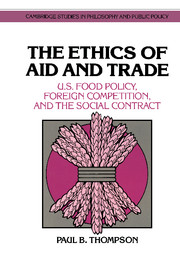Book contents
- Frontmatter
- Contents
- Acknowledgments
- Introduction: Of cabbages and kings
- 1 The food weapon and the strategic concept of food policy
- 2 The Bumpers Amendment
- 3 Does helping foreign industries violate a basic principle of government?
- 4 International agricultural assistance and the interests of U.S. agriculture
- 5 The trading state and the social contract
- 6 Humanitarianism, hunger, and moral theory
- 7 Morality and the myth of scarcity
- 8 The time has come, the walrus said, to speak of many things
- Notes
- References
- Index
1 - The food weapon and the strategic concept of food policy
Published online by Cambridge University Press: 20 May 2010
- Frontmatter
- Contents
- Acknowledgments
- Introduction: Of cabbages and kings
- 1 The food weapon and the strategic concept of food policy
- 2 The Bumpers Amendment
- 3 Does helping foreign industries violate a basic principle of government?
- 4 International agricultural assistance and the interests of U.S. agriculture
- 5 The trading state and the social contract
- 6 Humanitarianism, hunger, and moral theory
- 7 Morality and the myth of scarcity
- 8 The time has come, the walrus said, to speak of many things
- Notes
- References
- Index
Summary
The phrase “food as a weapon” is generally traced to Earl Butz, secretary of agriculture under Presidents Nixon and Ford, but the concept hardly could have originated with him. When princes defended themselves from marauders by retreating into the fortress castles of the medieval era, the siege – starving them out – was one of the attacker's tactical options. Butz's idea was that the United States might starve another nation into submission, not with a military blockade, but simply by refusing to sell or give them grain. Secretary Butz left a legacy of aphorisms that have come to haunt U.S. agricultural policy in the intervening years. His suggestion that the United States should regard food as a weapon in the conduct of bilateral foreign policy relations with the developing world is conceptually linked to his injunctions to “get big or get out” and to plant “fencerow to fencerow.” These precepts are linked by a vision of U.S. agriculture dominating undersupplied world grain markets well into the future. U.S. farmers could get rich while helping stave off worldwide hunger and famine, and the U.S. government would find a new source of power in world relations.
Butz was not alone in believing that food scarcity would preoccupy international diplomacy during the final quarter of the twentieth century. Food policy literature of the mid-to-late 1970s is full of dire predictions of undersupply and warnings of famine (Singer, 1972; ERS, 1974; Hardin, 1974; IFPRI, 1976).
- Type
- Chapter
- Information
- The Ethics of Aid and TradeU.S. Food Policy, Foreign Competition, and the Social Contract, pp. 20 - 40Publisher: Cambridge University PressPrint publication year: 1992



